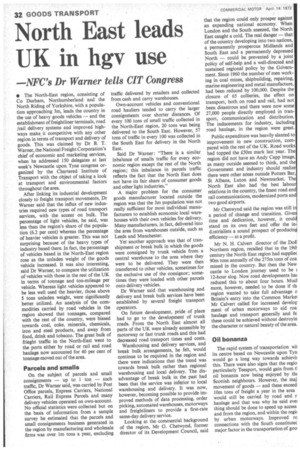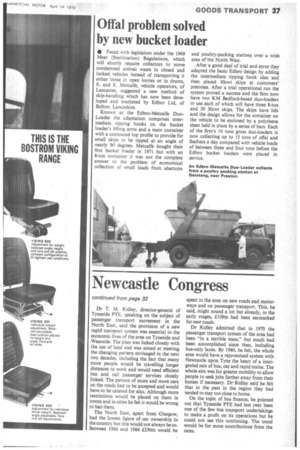North East leads UK in hgv use
Page 34

Page 39

If you've noticed an error in this article please click here to report it so we can fix it.
—NFC's Dr Warner tells CIT Congress
• The North-East region, consisting of Co Durham, Northumberland and the North Riding of Yorkshire, with a population approaching 3m, leads the country in the use of heavy goods vehicles — and the establishment of freightliner terminals, road /rail delivery systems and improved highways make it competitive with any other region in terms of transport and delivery of goods. This was claimed by Dr B. T. Warner, the National Freight Corporation's chief of economic and marketing services, when he addressed 150 delegates at last week's Newcastle upon Tyne congress organized by the Chartered Institute of Transport with the object of taking a look at transport and environmental factors throughout the area.
After linking its industrial development closely to freight transport movements, Dr Warner said that the influx of new industries required new types of road transport services, with the accent on bulk. The percentage of light vehicles, he said, was less than the region's share of the population (6,2 per cent) whereas the percentage of heavier vehicles is greater. This was not surprising because of the heavy types of industry based there. In fact, the percentage of vehicles based in the North-East region rose as the unladen weight of the goods vehicle increased. It was also interesting, said Dr Warner, to compare the utilization of vehicles with those in the rest of the UK in terms of tonnage and ton-mileage per vehicle. Whereas light vehicles appeared to be less well used the heavier, those above 5 tons unladen weight, were significantly better utilized. An analysis of the commodities carried by road vehicles in the region showed that tonnages, compared with the rest of the country, were biased towards coal, coke, minerals, chemicals, iron and steel products, and away from food, drink and tobacco. The great bulk of frieght traffic in the North-East went to the ports either by road or rail and road haulage now accounted for 40 per cent of tonnage moved out of the area.
Parcels and smalls
On the subject of parcels and small consignments — up to 1 ton — such traffic, Dr Warner said, was carried by Post Office parcels, Express Carriers, National Carriers, Rail Express Parcels and many delivery vehicles operated on own-account No official statistics were collected but on the basis of information from a sample survey he estimated that the parcels and small consignments business generated in the region by manufacturing and wholesale firms was over lm tons a year, excluding traffic delivered by retailers and collected from cash and carry warehouses.
Own-account vehicles and conventional road hauliers tended to carry the larger consignments over shorter distances. Of every 100 tons of small traffic collected in the North-East region, 20 tons was being delivered to the South East. However, 57 tons of traffic in every 100 was collected in the South East for delivery in the North East.
Said Dr Warner: "There is a similar inbalance of smalls traffic for every economic region except the rest of the North region; this inbalance in parcels traffic reflects the fact that the North East does not have its fair share of consumer goods and other light industries."
A major problem for the consumer goods manufacturer located outside the region was that the 3m population was not really sufficient for most individual manufacturers to establish economic local warehouses with their own vehicles for delivery. Many manufacturers, in fact, delivered into the area from warehouses outside, such as Leeds and Manchester.
Yet another approach was that of transhipment or break bulk in which the goods were consigned by trunk vehicle from a central warehouse to the area where they were to be delivered. They were then transferred to other vehicles, sometimes for the exclusive use of the consignor; sometimes they were loaded with other parcels onto delivery vehicles.
Dr Warner said that warehousing and delivery and break bulk services have been established by several freight transport operators.
On future development, pride of place had to go to the development of trunk roads. From the North East almost all parts of the UK were already accessible by motorway or fast trunk roads and this had decreased road transport times and costs.
Warehousing and delivery services, and break bulk arrangements, he felt, would continue to be required in the region and there were indications that the trend was towards break bulk rather than regional warehousing and local delivery. The disadvantage of break bulk in the past had been that the service was inferior to local warehousing and delivery. It was now, however, becoming possible to provide improved methods of data processing, order picking, automated warehouses, motorways and freightliners to provide a first-rate same-day delivery service.
Looking at the commercial background of the region, Mr G. Chetwynd, former director of its Development Council, said that the region could only prosper against an expanding national economy. When London and the South sneezed, the North East caught a cold. The real danger — that of the country developing into two nations, a permanently prosperous Midlands and South East and a permanently depressed North — could be prevented by a joint policy of self-help and a well-directed and sustained regional policy by the Ge7vernment. Since 1960 the number of men working in coal mines, shipbuilding, repairing, marine engineering and metal manufacture, had been reduced by 100,000. Despite the closure of 65 collieries, the effect on transport, both on road and rail, had not been disastrous and there were now some 27,000 people directly employed in transport, communication and distribution. The inducements for industry, including road haulage, in the region were great.
Public expenditure was heavily slanted to improvement in new construction, compared with the rest of the UK. Road works had topped the £50m mark last year. The region did not have an Andy Capp image, as many outside seemed to think, and the Government and industry should realize there were other areas outside Potters Bar, St Albans, Luton and Newmarket. The North East also had the best labou relations in the country, the finest road an rail communications, modernized ports an two good airports.
Mr Chetwynd said the region was still i a period of change and transition. Give time and dedication, however, it coul stand on its own feet and offer the in dastrialists a sound prospect of producin efficiency—at a profit.
Mr N. H. Calvert director of the DoE Northern region, recalled that in the 19t1' century the North East region had suppliec 90m tons annually of the 275m tons of coa mined in the country. But then the New castle to London journey used to be 12-hour slog. Now road developments ha( reduced this to about four hours. Mud more, however, needed to be done if th, region wanted to take full advantage o Britain's entry into the Common Markel Mr Calvert called for increased develop ment of urban motorways to aid roa haulage and transport generally and fe. these could be achieved without destroyin the character or natural beauty of the area.
Oil bonanza
The rapid system of transportation wil its centre based on Newcastle upon Tyn would go a long way towards achievit this. There were also signs that the regio particularly Teesport, would gain from ti oil bonanza now being enjoyed by th( Scottish neighbours. However, the maj movement of goods — and these exceed 10m tons of freight a year in the area would still be carried by road and r • haulage and that was why he said eve] thing should be done to speed up access and from the region, and within the regi( by urban motorways. Improved Do connections with the South constitutec major factor in the transportation of goo Dr T. M. Ridley, director-general of Tyneside PTE, speaking on the subject of passenger transport movement in the North East, said the provision of a new rapid transport system was essential to the economic lives of the area on Tyneside and Wearside. The plan was linked closely with the use of land and was aimed at meeting the changing pattern envisaged in the next two decades, including the fact that many more people would be travelling longer distances to work and would need efficient bus and rail passenger services closely linked. The pattern of more and more cars on the roads had to be accepted and would have to be catered for also. Although more restrictions would be placed on them in towns and in cities he felt it would be wrong to ban them.
The North East, apart from Glasgow, had the lowest figure of car ownership in the country but this would not always be so. Between 1966 and 1984 £250m would be spent in the area on new roads and motorways and on passenger transport. This, he said, might sound a lot but already, in the early stages, £109m had been earmarked for new roads.
Dr Ridley admitted that in 1970 the passenger transport system of the area had been "in a terrible mess," but much had been accomplished since then, including bus-only lanes. By 1980, he felt, the whole area would have a rejuventaed system with Newcastle upon Tyne the heart of a intergrated mix of bus, car and rapid trains. The whole aim was for greater mobility to allow people to seek jobs farther away from their homes if necessary. Dr`Ridley said he felt that in the past in the region they had tended to stay too close to home.
On the topic of bus finance, he pointed out that Tyneside PTE had last year been one of the few bus transport undertakings to make a profit on its operations but he could not see this continuing. The trend would be for more contributions from the rates.




















































































































































